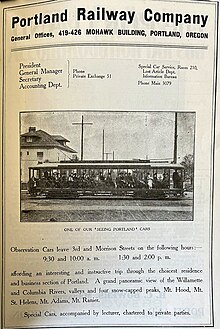Portland Railway, Light and Power Company
 | |
| Company type | Public |
|---|---|
| Industry | Public utility |
| Founded | 1906 |
| Fate | Acquired by Portland Electric Power Company (1924) |
| Headquarters | Portland, Oregon, U.S. |
Key people | Franklin Griffith[1] |
| Products | Electric power, transportation |
The Portland Railway, Light and Power Company (PRL&P) was a railway company and electric power utility in Portland, Oregon, United States, from 1906 until 1924.[2]
History



A series of mergers of various transportation companies in 1905–1906
The company's interurban lines used
By 1910, PRL&P was a $15 million
PRL&P's president, Franklin Griffith, was part of the corruption and graft surrounding Mayor George Luis Baker; Griffith and others paid off Baker's mortgage.[1]

PRL&P was reorganized as the Portland Electric Power Company (PEPCO) on April 26, 1924.[2]
Two former PRL&P streetcar buildings are listed on the National Register of Historic Places. Bay E of the West Ankeny Carbarns was listed in 1978,[8] and the Sellwood Division Carbarn Office and Clubhouse was listed in 2002.[9] The company's 1911 hydroelectric facility in Estacada, Oregon, the River Mill Hydroelectric Project, is also listed on the NRHP.[10]
See also
References
- ^ OCLC 928581539.
- ^ ISBN 0-7385-3115-4.
- ^ ISBN 0-87004-287-4.
- ^ Tucker, Kathy (2003). "Portland Railway Company Car (photo)". Oregon Historical Society.
- ISBN 978-0-7385-8126-2.
- ^ OCLC 2645815.
- ^ Cited in MacColl as "American Banker", May 28, 1910
- ^ Alfred M. Staehli (March 2, 1978). "National Register of Historic Places Inventory – Nomination Form: Bay E, West Ankeny Car Barns" (PDF). National Park Service. Retrieved December 26, 2014.
- ^ Dodds, Linda; Dodds, Gordon (June 1, 2001). "National Register of Historic Places Registration Form: Portland Railway, Light and Power Sellwood Division Carbarn Office and Clubhouse" (PDF). National Park Service. Retrieved April 22, 2012.
- ^ https://npgallery.nps.gov/NRHP/GetAsset/NRHP/01000497_text
Further reading
- Mills, Randall V. (March 1943). "Early Electric Interurbans in Oregon". Oregon Historical Quarterly. 44 (1): 82–104. JSTOR 20611476.
External links
- Kramer, George. "Portland Railway, Light and Power Company". The Oregon Encyclopedia.
